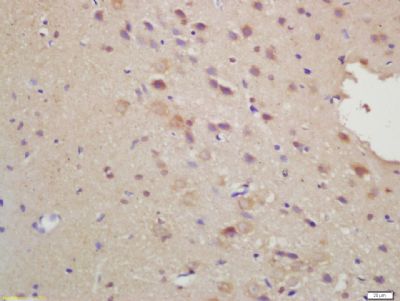FbxO6 Polyclonal Antibody
Purified Rabbit Polyclonal Antibody (Pab)
- SPECIFICATION
- CITATIONS
- PROTOCOLS
- BACKGROUND

Application
| IHC-P, IHC-F, IF, E |
|---|---|
| Primary Accession | Q9NRD1 |
| Reactivity | Rat, Pig, Dog, Bovine |
| Host | Rabbit |
| Clonality | Polyclonal |
| Calculated MW | 34 KDa |
| Physical State | Liquid |
| Immunogen | KLH conjugated synthetic peptide derived from human FbxO6 |
| Epitope Specificity | 101-200/293 |
| Isotype | IgG |
| Purity | affinity purified by Protein A |
| Buffer | 0.01M TBS (pH7.4) with 1% BSA, 0.02% Proclin300 and 50% Glycerol. |
| SUBCELLULAR LOCATION | Cytoplasm. |
| SIMILARITY | Contains 1 F-box domain. Contains 1 FBA (F-box associated) domain. |
| SUBUNIT | Interacts with VCP. |
| Important Note | This product as supplied is intended for research use only, not for use in human, therapeutic or diagnostic applications. |
| Background Descriptions | The F box, named after cyclin F in which it was originally observed, is an approximately 40-amino acid motif that binds SKP1. F-box proteins are components of modular E3 ubiquitin protein ligases called SCFs (SKP1, cullin, F-box proteins), which function in phosphorylation-dependent ubiquitination. |
| Gene ID | 26270 |
|---|---|
| Other Names | F-box only protein 6, F-box protein that recognizes sugar chains 2, F-box/G-domain protein 2, FBXO6, FBG2, FBS2, FBX6 |
| Dilution | IHC-P=1:100-500,IHC-F=1:100-500,IF=1:100-500,ELISA=1:5000-10000 |
| Format | 0.01M TBS(pH7.4), 0.09% (W/V) sodium azide and 50% Glyce |
| Storage | Store at -20 ℃ for one year. Avoid repeated freeze/thaw cycles. When reconstituted in sterile pH 7.4 0.01M PBS or diluent of antibody the antibody is stable for at least two weeks at 2-4 ℃. |
| Name | FBXO6 |
|---|---|
| Synonyms | FBG2, FBS2, FBX6 |
| Function | Substrate-recognition component of some SCF (SKP1-CUL1-F-box protein)-type E3 ubiquitin ligase complexes. Involved in endoplasmic reticulum-associated degradation pathway (ERAD) for misfolded lumenal proteins by recognizing and binding sugar chains on unfolded glycoproteins that are retrotranslocated into the cytosol and promoting their ubiquitination and subsequent degradation. Able to recognize and bind denatured glycoproteins, which are modified with not only high- mannose but also complex-type oligosaccharides. Also recognizes sulfated glycans. Also involved in DNA damage response by specifically recognizing activated CHEK1 (phosphorylated on 'Ser-345'), promoting its ubiquitination and degradation. Ubiquitination of CHEK1 is required to ensure that activated CHEK1 does not accumulate as cells progress through S phase, or when replication forks encounter transient impediments during normal DNA replication. |
| Cellular Location | Cytoplasm. |

Thousands of laboratories across the world have published research that depended on the performance of antibodies from Abcepta to advance their research. Check out links to articles that cite our products in major peer-reviewed journals, organized by research category.
info@abcepta.com, and receive a free "I Love Antibodies" mug.
Provided below are standard protocols that you may find useful for product applications.
If you have used an Abcepta product and would like to share how it has performed, please click on the "Submit Review" button and provide the requested information. Our staff will examine and post your review and contact you if needed.
If you have any additional inquiries please email technical services at tech@abcepta.com.













 Foundational characteristics of cancer include proliferation, angiogenesis, migration, evasion of apoptosis, and cellular immortality. Find key markers for these cellular processes and antibodies to detect them.
Foundational characteristics of cancer include proliferation, angiogenesis, migration, evasion of apoptosis, and cellular immortality. Find key markers for these cellular processes and antibodies to detect them. The SUMOplot™ Analysis Program predicts and scores sumoylation sites in your protein. SUMOylation is a post-translational modification involved in various cellular processes, such as nuclear-cytosolic transport, transcriptional regulation, apoptosis, protein stability, response to stress, and progression through the cell cycle.
The SUMOplot™ Analysis Program predicts and scores sumoylation sites in your protein. SUMOylation is a post-translational modification involved in various cellular processes, such as nuclear-cytosolic transport, transcriptional regulation, apoptosis, protein stability, response to stress, and progression through the cell cycle. The Autophagy Receptor Motif Plotter predicts and scores autophagy receptor binding sites in your protein. Identifying proteins connected to this pathway is critical to understanding the role of autophagy in physiological as well as pathological processes such as development, differentiation, neurodegenerative diseases, stress, infection, and cancer.
The Autophagy Receptor Motif Plotter predicts and scores autophagy receptor binding sites in your protein. Identifying proteins connected to this pathway is critical to understanding the role of autophagy in physiological as well as pathological processes such as development, differentiation, neurodegenerative diseases, stress, infection, and cancer.


